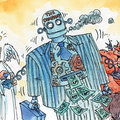The new financial order is undergoing its harshest test. It will not be pretty, but it is necessary
| |
 | |
THE lifeguards had been scanning the horizon for an oil-price shock, a bankrupt buy-out or a terrorist attack. But when the big wave struck last week it surprised them by coming from inside the financial system and threatening to swamp an unlikely shore, the money markets where banks lend to each other to help cover their daily operations. Investors have been asking for years if the frantic innovation in finance, especially the securitisation of just about every form of debt into a tradable asset, was a way to spread risk efficiently, or whether this left the financial system prone to rare—but cataclysmic—failures. It looks as if investors are about to find out.
Over the past week central banks have lent tens of billions of dollars to restore confidence to the markets (see article). But it is already clear that this mess is about more than a bit of rash mortgage lending to Americans who were in the habit of falling behind with their monthly payments. Hedge funds and private-equity firms, kings of the boom, are nursing big losses. Debt markets that once handed out cash to all comers are tight or closed altogether. In almost every asset market, investors are scurrying to reprice risk—which mostly means to reduce it.
The gravest and most immediate threat is to the banking system. For the time being, banks no longer trust other banks enough to lend them money except on onerous terms; equally worryingly, they lack confidence that other banks will trust them if they want to borrow. It is alarming when the very outfits that exist to supply the economy with credit start to hoard it from each other. At best this tightens monetary policy; at worst, a shortage of cash will cripple the payments system and cause runs on otherwise solvent banks and businesses that cannot rapidly raise funds.
Underneath all the new technology and the fancy derivatives with strange acronyms is a dilemma as old as banking itself. Anyone who thinks that lending has been too loose—and many bankers do—should welcome a purge: better now than later when the imbalances would be bigger and the economy probably weaker. But if good banks fail and money for good companies dries up, the purge will wreak huge and wasteful damage on healthy parts of the economy. How likely is that?
Financial crises are always about the way people do business, and not just the deals they have struck. Yet this one goes deeper than most. The spreading panic has shown up weaknesses in some of the foundations of modern finance. The past 20 years have created untold wealth. As securities and markets have steadily taken the place of old-style bank managers, the number of potential investors has grown and the cost of capital has fallen. Much good has come of that.
But there is a price that is only now becoming apparent. Because lenders expected to be able to sell on the risk of default to someone else, they lent too easily. After all, they would not have to pick up the pieces. In theory, that risk should have been borne by the people best able to carry it. But with everybody having sold on the risk to everyone else—and the risk often being carved up, repackaged and sold again—nobody is sure where the losses are. The fear is that some risks ended up with those who least understood what they were getting into, and fear is a potent force in this disintermediated world. In the interbank market, every counterparty was potentially vulnerable. Even small amounts of bad credit can drive out good.
In theory, ratings agencies and mathematical models help investors price the risk they are taking on, even if the securities they are buying are scarcely traded. Yet when some supposedly good-quality assets proved to be worth little, people lost faith in the models and the ratings. Across the board, investors had failed to take account of how fast and how far asset prices fall when everyone wants to sell at the same time. Hard-to-sell long-term securities had been bought with short-lived debt, which left borrowers vulnerable to a change in sentiment every time the debt fell due. It does nothing to restore confidence when the biggest model-driven hedge funds had to get in new money. The people at Goldman Sachs lost a packet when something happened that their computers told them should occur only once every 100 millennia.
The retreat to a new level of risk was never going to be orderly or free of casualties. Neither should it be. Bankers and investors need to suffer precisely because the methods of modern finance have been found wanting. It sounds Darwinian, but the brutal demonstration that you pay for your sins is what leads the system to evolve. Markets learn from their mistakes. Only fear will spur investors to price risks better and get them to put more effort into monitoring their counterparties.
If these lessons are to sink in, central bankers must stand back—as, by and large, they have done. Every intervention now will be taken as a sign of what the regulators will do next time. If they bail out banks that have mispriced risk, the mispricing will continue. And when the central banks do step in, it should not be to save the financiers. The cost of intervention is warranted only to save the rest of the economy from the financiers' folly. By that test, central banks were right to lend money to the banks in recent days, because it ensured that a liquidity crisis did not become a solvency crisis. They may yet have to take over a failed bank, though only if that is needed to stop a run. It is still far too soon to cut interest rates.
Because this crisis taps so deeply into the newly devised structures of finance, anyone who says the worst is definitely over is either a fool or someone with a position to protect. As risk has become bewilderingly dispersed, so too has information. Nobody yet knows who will bear what losses from mortgages—because nobody can be sure what those loans are really worth. Nobody knows if tighter lending standards will oblige borrowers to raise more capital, triggering more sales in stockmarkets and more pain. Nobody knows how messy the inevitable bankruptcies will turn out to be. What markets need now is time to piece that information back together. Time before the next wave strikes.




